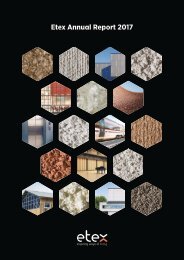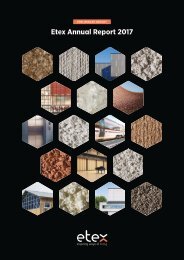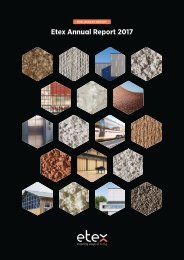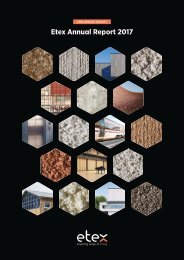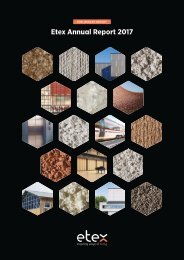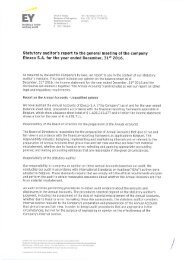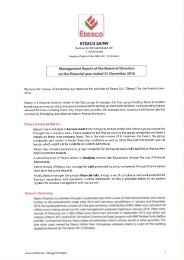ETX-10829_Etex-AR2017_WEB_2018_DEF2 (2)
Create successful ePaper yourself
Turn your PDF publications into a flip-book with our unique Google optimized e-Paper software.
4.3<br />
Social report<br />
Carefully managing our asbestos past<br />
<strong>Etex</strong> Annual Report 2017<br />
Social report<br />
Carefully managing our asbestos past<br />
Carefully managing<br />
our asbestos past<br />
Asbestos is part of our past and<br />
we continue to manage our<br />
history with the material carefully.<br />
Our group-wide policy makes this<br />
commitment concrete.<br />
Asbestos: key facts<br />
Since its discovery, this naturally occurring,<br />
industrially relevant mineral was used,<br />
and is still used, around the globe by<br />
various sectors.<br />
It was only after asbestos was firmly<br />
embedded in many industrial processes<br />
and products that the health implications<br />
of inhaling asbestos fibres became clear.<br />
Unfortunately, it has taken the world<br />
decades to fully understand the risks<br />
associated with asbestos exposure.<br />
Asbestos occurs in nature<br />
a set of minerals<br />
that occur naturally<br />
as bundles of fibres<br />
that can be separated into threads<br />
Asbestos has numerous<br />
industrially relevant properties<br />
Heat and fire resistant Resistant to chemicals Non-conductive<br />
Asbestos through the years<br />
Prior to a complete ban in 2002, some of<br />
our companies used asbestos as a raw<br />
material in production.<br />
Preventive measures<br />
Starting in the 1970s, <strong>Etex</strong> companies took<br />
measures to reduce asbestos concentration<br />
levels in their factories. These include:<br />
• masks and other protective gear<br />
• dust extraction equipment<br />
• a shift from dry to wet production<br />
• automating production processes<br />
• exploring alternative materials<br />
• banning blue, brown and<br />
later white asbestos.<br />
These measures were aligned with the<br />
legislation and scientific knowledge<br />
available at the time and were considered<br />
effective ways to prevent health risks.<br />
However, scientific and medical knowledge<br />
further evolved, indicating later that<br />
this was not sufficient and that some<br />
risks persisted. The fact that asbestosrelated<br />
diseases take an average of 45<br />
years from the start of the exposure to<br />
develop diseases has certainly slowed<br />
down or influenced the progression of<br />
scientific understanding.<br />
Stringent regulations<br />
Health provisions<br />
Since asbestos-related illnesses have<br />
a long latency period, <strong>Etex</strong> companies<br />
may still receive claims related to former<br />
asbestos exposure. Our companies provide<br />
for the settlement costs for past and<br />
future claims as part of our commitment<br />
to compensation.<br />
Several variables affect how compensation<br />
is calculated, and these may change<br />
over time. We therefore regularly review<br />
our approach to accommodate any new<br />
information that may become available.<br />
Group-wide policy<br />
We cannot undo the past and we regret<br />
any victim of asbestos exposure.<br />
To put adequate support systems in<br />
place, we established a mandatory policy<br />
in place that enables our companies to<br />
manage their pasts vigilantly. The policy<br />
is supported by four pillars: compensate<br />
victims, manage landfills, prevent exposure<br />
and support research.<br />
It is our sincerest hope that treatment<br />
for asbestos-related illnesses will benefit<br />
from medical and scientific research in<br />
the future.<br />
€ 6,000,000<br />
donated to the Foundation Against<br />
Cancer between 2012 and 2020.<br />
Compensate victims<br />
<strong>Etex</strong> companies have to ensure that<br />
those who become seriously ill due to<br />
the use of asbestos in their factories<br />
receive a fair financial compensation.<br />
Prevent exposure<br />
<strong>Etex</strong> companies regularly monitor<br />
1 policy, 4 principles for the presence of airborne fibres<br />
and safely manage all buildings.<br />
Mechanical strength Rot-proof Affordable<br />
Asbestos has been used in various industries and applications since the late 1800s<br />
Insulation<br />
industry<br />
Automotive<br />
industry<br />
Textile<br />
industry<br />
Plastics<br />
industry<br />
Food<br />
industry<br />
Throughout the 1980s and 1990s, the use of<br />
asbestos was more strictly regulated and<br />
in 2005, the European Union completely<br />
prohibited its use.<br />
The global picture<br />
Despite the European ban, asbestos<br />
continues to be used elsewhere in the<br />
world. In some cases, it is used by<br />
companies bearing the Eternit brand name<br />
that are by no means part of <strong>Etex</strong>.<br />
Compensate victims<br />
<strong>Etex</strong> companies have to ensure that<br />
those who become seriously ill due to<br />
the use of asbestos in their factories<br />
receive a fair financial compensation.<br />
Manage landfills<br />
To avoid possible exposure,<br />
landfill sites owned by <strong>Etex</strong><br />
companies are managed<br />
skilfully and responsibly.<br />
Shipbuilding<br />
Construction<br />
and building<br />
Power<br />
plants<br />
Home<br />
appliances<br />
Railroad<br />
vehicles<br />
This is because Eternit is also the name of<br />
the technology used to make asbestosreinforced<br />
cement. In the early 1900s, the<br />
technology patent was sold to individual<br />
companies, several of which adopted and<br />
have retained the name.<br />
Prevent exposure<br />
<strong>Etex</strong> companies regularly monitor<br />
for the presence of airborne fibres<br />
and safely manage all buildings.<br />
Support research<br />
<strong>Etex</strong> backs medical and<br />
scientific research into<br />
asbestos-related illnesses.<br />
82 83<br />
Manage landfills



